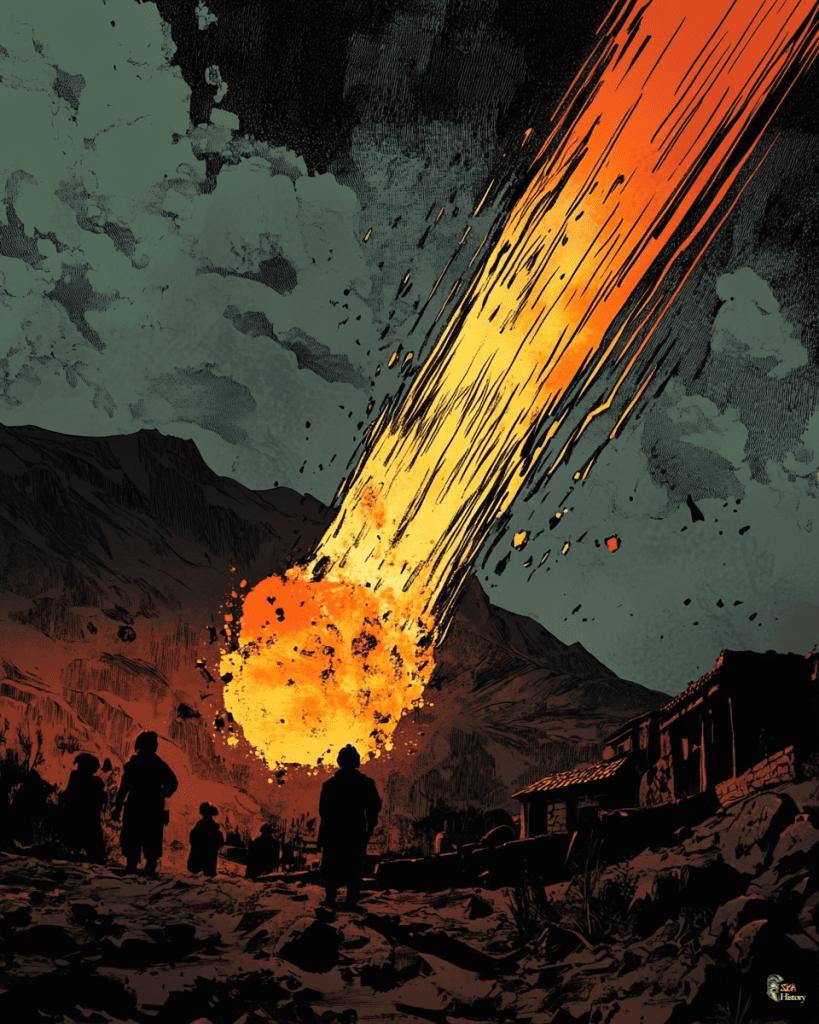On September 15, 2007, a remarkable event occurred near the village of Carancas in Peru, close to Lake Titicaca. A meteorite, later classified as an H4-5 ordinary chondrite, plummeted to Earth, creating a significant impact crater.
This celestial visitor captivated scientists and locals alike, offering a rare opportunity to study a fresh meteorite impact site.
The Carancas meteorite impact was extraordinary for several reasons. The event created a crater measuring 14.2 meters across, making it one of the smallest and youngest impact craters ever witnessed on Earth.
Villagers reported seeing a fireball streak across the sky before impact, providing valuable eyewitness accounts of the meteorite’s descent.
Scientists quickly descended upon the site to study this rare occurrence. The meteorite fragments recovered contained olivine and chondrules, typical components of stony meteorites.
Researchers from institutions like the University of Arizona and INGEMMET (Peru’s geological survey) meticulously examined the crater, ejecta, and meteorite fragments, piecing together the story of this cosmic encounter.
Carancas Meteorite Event
The 2007 Carancas meteorite impact was a rare and remarkable occurrence that caught the attention of scientists and locals alike. This extraordinary event provided valuable insights into meteorite impacts and their effects on Earth.
September 15 Impact
On September 15, 2007, at 11:40 local time, a chondritic meteorite crashed near the village of Carancas in Peru’s Puno Region. The impact created a crater approximately 13 meters wide and 4.5 meters deep. This event was unique as it became one of only two eye-witnessed impact crater formations on Earth.
The meteorite was classified as an H4-5 chondrite, a type of stony meteorite. Its impact left visible scorch marks on the earth surrounding the crater, providing researchers with valuable data on the effects of such collisions.
Peruvian Village Encounter
The residents of Carancas experienced a truly extraordinary event that day. Witnesses reported seeing a fireball streaking across the sky before the impact. The collision sent debris flying and created a plume of dust visible from a considerable distance.
Curious villagers approached the crater to investigate, some collecting fragments of the meteorite. Researchers, including scientists from Brown University, soon arrived to study the site. They found the event particularly intriguing due to its rarity and the opportunity it presented to study a fresh impact crater.
Infrasound Detection
The Carancas impact was significant enough to be detected by sophisticated monitoring equipment. Infrasound records captured the event’s acoustic signature, providing valuable data for researchers.
Analysis of these infrasound measurements revealed that the impact released approximately 10^10 joules of energy. This is equivalent to about 2-3 tons of TNT, highlighting the tremendous force of even a relatively small meteorite strike.
The infrasound data, combined with seismic records and eyewitness accounts, allowed scientists to piece together a comprehensive understanding of the event. This multi-faceted approach to studying the Carancas impact has greatly enhanced our knowledge of meteorite strikes and their effects on Earth.
Scientific Investigation
The Carancas meteorite impact sparked intense scientific curiosity, prompting researchers to examine its composition and origins. Experts from various institutions conducted thorough analyses to unravel the mysteries of this rare event.
Classification and Composition
Scientists classified the Carancas meteorite as an H4-5 chondrite, a type of stony meteorite. This classification provided valuable insights into its formation and cosmic journey.
The meteorite’s composition included olivine and chondrules, typical features of ordinary chondrites.
Researchers discovered fragments of the meteorite scattered around the impact site. These pieces exhibited a fusion crust, a thin melted layer formed during atmospheric entry. The presence of breccia, a rock composed of broken fragments, offered clues about the meteorite’s violent history.
University of Arizona Analysis
The University of Arizona played a crucial role in studying the Carancas impact event. Their team conducted detailed examinations of the crater and meteorite fragments.
Researchers used advanced techniques to analyze the meteorite’s chemical makeup. They focused on understanding how the object survived its fiery descent through Earth’s atmosphere.
The university’s findings shed light on the meteorite’s unusual ability to reach the ground intact, a rare occurrence for objects of its size.
Their analysis also contributed to estimating the impact energy. By studying the crater’s dimensions and the surrounding ejecta, they helped determine the force of the collision.
INGEMMET’s Role
INGEMMET, Peru’s geological, mining, and metallurgical institute, led the initial investigation.
Luisa Macedo, a researcher from INGEMMET, visited the site shortly after the impact.
The institute’s team collected meteorite samples and documented the crater’s characteristics. They measured the crater’s dimensions, recording it as 13.5 meters wide.
INGEMMET’s swift response provided crucial early data about the impact event.
Their involvement ensured that Peruvian scientists played a crucial part in studying this significant geological occurrence on their soil. INGEMMET’s work laid the foundation for subsequent international research collaborations.

